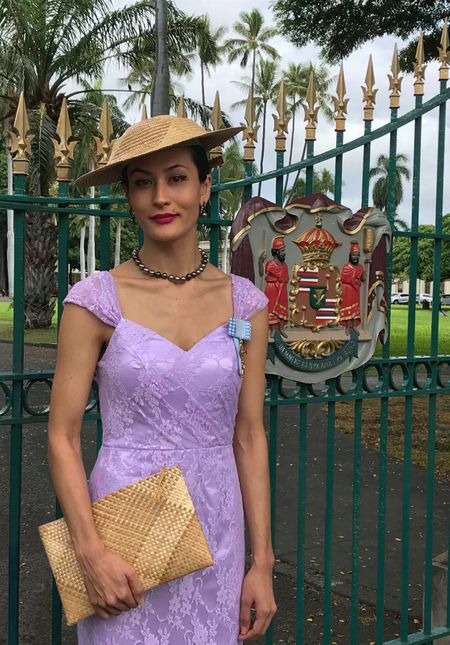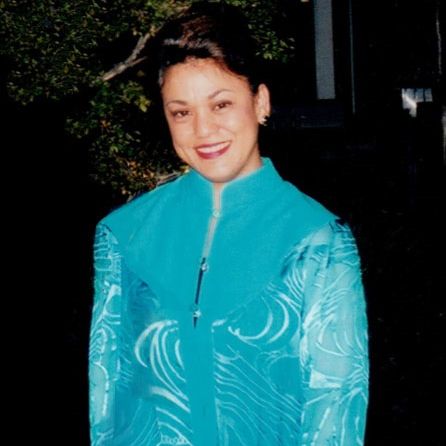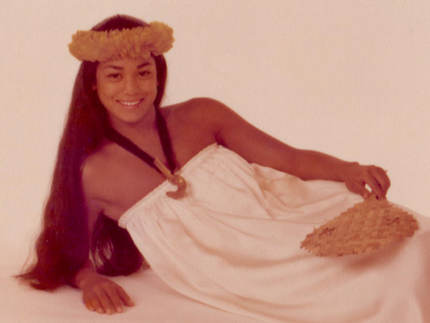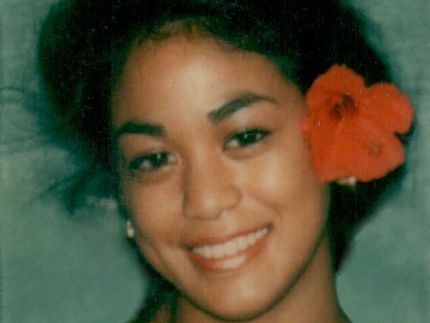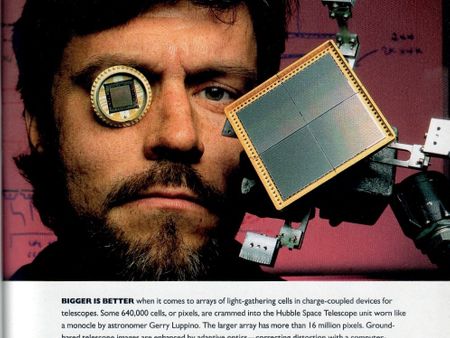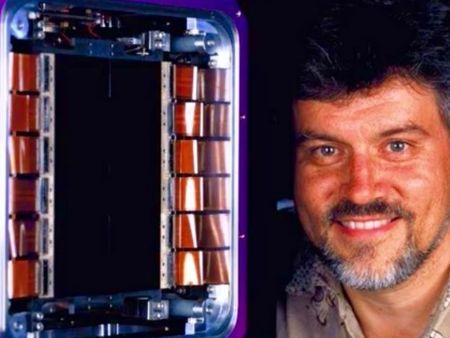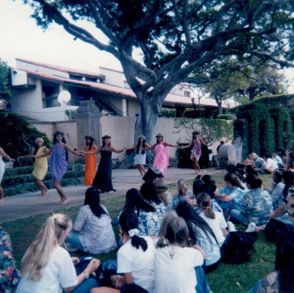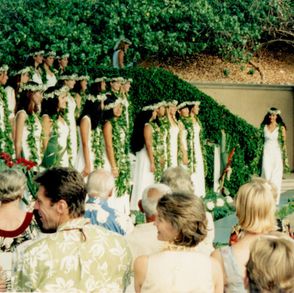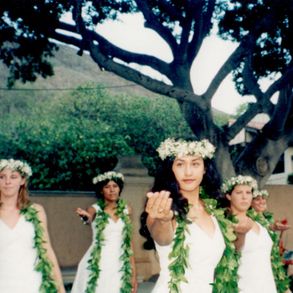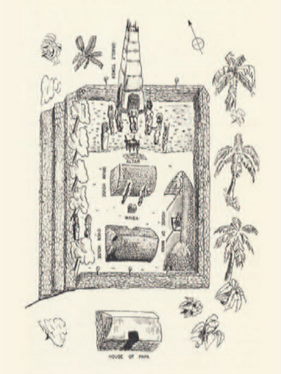Ke Ali'i/H.R.H. Princess Idony Punahele Hoapili
Ke ali'i (H.R.H. Princess) Idony Punahele Hoapili was appointed the Head of the royal organizational entity that represents the Hoapili Baker Family royal name, heritage and legacy, appointed by the legal Senior Heir and Head of the Hoapili Baker Family, ke ali'i (H.R.H. Prince) George 'Ī'ī Baker, on January 10th, 2020. Effective January 10, 2022, ke ali'i Idony Punahele continues her position as Head with the name of the Royal House federally changed in Hawai'i to the Royal House of Hawai’i – Ka Hale Ali’i O Hoapili Baker.
On September 30th, 2023, ke ali'i Idony Punahele wed an illustrious personage of royal blood from one of the oldest European family lines with a ruling heritage that dates back three millenia, an honorable humanitarian and philanthropist from multiple, pan-European royal bloodlines and high noble bloodlines, the former Officer-in-Chief and very proactive and appreciated monarchist, Senhor Dom (Lord) Alfredo Côrte-Real of Portugal.
Born and raised on the island of Oahu, ke ali'i Idony Punahele is also of Irish, Portuguese and Spanish ancestry from her maternal Hawaiian side, the side of her royal heritage. Her Hawaiian first name is Punahele, and she was given an ancestral name of her family, Hoapili, which she took and joined to her last name upon her marriage, honoring the royal tradition of her Hawaiian lineage. Her last name is now Hoapili Côrte-Real, ensuring that the children that she will have carry the Hawaiian royal name.
In the consultation and blessings of her kupuna and family, ke ali'i Idony Punahele Hoapili made a wise decision for the Royal legacy of Hawai'i, and for King Kalakaua's international vision, by marrying into antiquity and esteemed royal blood with the man she respects and loves.
Ke ali'i Idony Punahele Hoapili is adept in the art of languages, an area that she enjoys and a skill that she relies on in her responsibilities serving as the Head of the Royal Family. Multilingual in French, Italian and Russian, she continues to develop her communicative skills in Portuguese and Spanish, and she is learning Danish and Greek. She is always eager to learn more 'Ōlelo Hawai'i (Native Hawaiian), a language that was forbidden to be spoken by the American Provisional Government under threat of severe penalties and which Queen Lili'u'okalani bade her people not to speak in the interest of their safety. It is a language that has slowly and cautiously been resurfacing since the Hawaiian cultural renaissance in the 1970's and 1980's and now enjoys some fluency again in a steadily growing number of Hawaiian language immersion schools.
Ke Ali'i Idony Punahele is a Catholic Christian and was baptized in her infancy in the Church of the Holy Trinity in her native Hawai'i Kai, Oahu. Active at an early age in gymnastics and at halau hula (school of Hawaiian dance), she cultivated her appreciation for the art of ancient Hawaiian dance with her grandmother in Halau Hula O Maiki under the direction of Kumu (Instructor) Maiki Aiu Lake, and later dancing in Halau Hula Kamamolikolehua under the direction of Kumu Hula Pohai Souza. In high school ke ali'i Idony Punahele excelled in the studies of languages, history and theatre. The ancient Hawaiian culture, craftsmanship, combat, poetry, legends and the expression of hula kahiko (ancient style of dance) profoundly impact upon ke ali'i Idony Punahele's professional work in cinema and fine art as acutely appreciated sources of inspiration. She has been involved in the film industry and on film sets with some of her family members since the age of seven.
After high school in Honolulu ke ali'i Idony Punahele took the intiative to study and work internationally, following in the footsteps and vision of her royal ancestors, H.R.H. Princess Victoria Ka'iulani, King David Kalākaua and his cousin and aide-de-camp Prince Colonel Robert Hoapili Baker I, who promoted and legislated the significance of harnessing the benefits of international perspectives and education abroad for future leadership skills. Since her adolescence she travelled internationally with her late father, a high-profile astrophysicist who was raised in a Catholic family, who also encouraged her to study abroad. She was educated in several countries in the areas of linguistics, world history, cinema, animated cinema, theatre production, and fine art, and holds a Master of Fine Art in a specialized area of cinema. Outside the area of studying King Kalakaua's avant-garde vision, diplomatic principles, academic investment, and the ever-present importance of the progressive objectives of the Hale Naua Society, preparing culturally, socially and internationally for her role as Royal Heir, she has worked professionally as an independent film director and animator in Europe.
Recognizing that one of the best and modern ways to educate is through the medium of cinema, ke ali'i Idony Punahele is an active proponent for the production of feature, short and documentary films and series about the history of the Kingdom of Hawai'i, the lives and experiences of its sovereigns, its kingdom-era allies, and the Hawaiian culture. She has great interest in producing films on the same monarchic themes concerning truthful and historical information about various kings and dynasties of the Kingdom of Portugal, and the current legitimate Royal House of Portugal, in collaboration with her husband, Prince Alfredo. H.R.H. Princess Idony Punahele and Prince Alfredo Maria are both jury members and partners of a sucessful, International Art and Tourism Film Festival founded in Portugal called Finisterra, for which they are establishing through The Hoapili Baker Foundation a chapter of the festival in Hawai'i with the objective of better promoting and sharing the cinematic work of Native Hawaiian filmmakers at the international level.
As the Royal Heir of the non-ruling Royal House of Hawai'i, H.R.H. Princess Idony Punahele attends annual state ceremonies and events of royal tribute to kings and queens of the Kingdom of Hawai'i every year with her family in Hawai'i. She lives with her husband between Hawai'i and Europe, and when in Europe, lives principally between their residences in northern Portugal and in northwestern Spain. She shares a love of philanthropy, medieval history, medieval patrimony, film, opera, horses and trekking in the wildnerness with her husband, Prince Alfredo. As the Executive Director of International Relations for The Hoapili Baker Foundation, she honors an obligation to service through the European expansion of King Kalakaua's "Hawaiian Youth's Abroad" student program for international studies, which was legislated by Prince Robert Hoapili Baker I. She is inspired by the mana (in Hawaiian, mana translates to life force of natural power) of one of her greatest philanthropic beacons, her beloved and dynamic mother, ke ali'i Princess Georgette Pua'ala (née Baker) Luppino, who has always been a proactive proponent of advanced education for Native Hawaiians.
Ke ali'i Georgette Pua'ala is the eldest child of the blood of ke ali'i George Ī'ī. She is a graduate of the Kamehameha Schools Kapalama and studied Business at the University of Hawai'i. She has worked at the University of Hawai'i Mānoa for the Joint Institute for Marine and Atmospheric Research (JIMAR), the Institute for Astronomy (IfA), and the City and County of Honolulu on Mayor Eileen R. Anderson's cabinet.
Ke ali'i Georgette was a core member of Honolulu-based fashion designer, Anne Namba Designs, with her expertise in international business marketing as a sales director for Neighbor Island accounts. She was a business partner for luxury jewelery designer, Silverpaige Designs and CEO for Asian Pacific Collection, a purveyor of Pacific and Asian jewelry, art, and antiques, and is often consulted in person in Hawai'i by her global clients. Besides donating art and antiques to benefit charity auctions in Hawai'i, accessories from her collections interest artists who purchase for their runway shows, including designers Ralph Lauren and Donna Karan, as well as Iron Chef, restauranteur Masaharu Morimoto.
Ke Ali'i/H.R.H. Princess Georgette Pua'ala
Ke Ali'i Georgette Pua'ala abdicated her position as Royal Heir and Head in favor of her daughter and eldest child, in agreement with the choice of her father, Ke Ali'i George I'i. After the passing of her late husband, Dr. Gerard Luppino, in 2016, ke ali'i Georgette Pua'ala served as the CEO of GLScientific Inc, becoming the only female native Hawaiian to serve as Chief Executive Officer for a high-tech aerospace development company with lasting ties to NASA and many other scientific instrumental corporations worldwide. Ke ali'i Georgette Pua'ala serves on many charitable Boards in Honolulu, including as the Chairwoman and CEO of The Hoapili Baker Foundation.
Ke Ali'i Georgette Pua'ala, Aloha Princess 1978
Ke Ali'i Georgette Pua'ala, University of Hawai'i
Dr. Gerard "Gerry" Anthony Luppino (1959 – 2016)
Ke ali'i Idony Punahele Hoapili's late father, Dr. Gerard Anthony Luppino, who raised her from age five, was a respected Nobel-credited astrophysicist who earned his PhD from the Massachusetts Institute of Technology (M.I.T.) in 1989 after having been recruited out of the U.S. Air Force. He was a consultant for projects of NASA, an original designer and manufacturer of his own aerospace instruments for space stations, satellites, telescopes and observatories worldwide, and a consultant for international military applications. After retiring as a professor from the University of Hawai'i Institute for Astronomy (IfA), Dr. Luppino founded GLScientific Inc., a high-tech aerospace development company, and was a renowned CCD (Charged Coupled Device) Detector expert at the University of Hawai'i Institute for Astronomy (IfA), the Mauna Kea and Haleakala Observatories, the M.I.T. Lincoln Lab, and many observatories on the west and east coasts of the U.S.A. and international observatories. He designed and manufactured CCDs for the Hubble Space Telescope (HST) satellite and the Transiting Exoplanet Survey Satellite (TESS), among other aerospace institutions and observatories worldwide. Dr. Luppino was a pioneer in the field of astrophysics and an invaluable mentor to many students and professionals. He was a generous philanthropist toward many organizations in Hawai'i, but particularly for academic causes, and annually donated scientific equipment to high schools.
A creative resourcefulness with materials in her beloved father's Honolulu laboratory allowed ke ali'i Idony Punahele Hoapili to build a natural bridge into the technical applied arts of cinematography and experimental mechanics of character design for animation from her universe of sculpture, theatre production design, acting and dance. Members of the Hoapili Baker 'Ohana, Hawaiian and international colleagues and many kanaka maoli are proud of Dr. Luppino's contributions to science and technology on Mauna Kea and abroad, and The Hoapili Baker Foundation endeavors to continue furthering educational opportunities for Native Hawaiians in these areas.
Portrait for National Geographic Magazine, "New Eyes On The Universe", Vol. 185, No. 1, January 1994
The CFH12K Camera, designed and built by Dr. Luppino, is the Institute for Astronomy's first Large CCD Mosaic Camera, the instrument whose design rendered possible the 2011 Nobel Prize in Physics
The Royal House of Hawai'i – Ka Hale Ali'i O Hoapili Baker respects the beliefs and customs of Native Hawaiians, while endeavoring, in this modern age, to pursue progressive technological science and educational opportunities for the keiki of the next generation. Through her professional work as a film producer, animator and director, and the Hoapili Baker ohana's philanthropic arm, The Hoapili Baker Foundation, ke ali'i Princess Idony Punahele Hoapili is enthusiastic about promoting advanced education, and is keen to promote her Hawaiian and Tahitian cultural heritage internationally. Residing in both Hawai’i and Europe, she proudly represents her kupuna and her extended Hoapili Baker ohana in Hawai'i and internationally.
Education
(Main Institutions)
La Pietra – Hawai'i School for Girls, Honolulu, Hawai'i, 2001
Bryn Mawr College, Bryn Mawr, Pennsylvania, Sculpture; Linguistics; Russian;Theatre Production Design, 2005
Edinburgh College of Art, Edinburgh, Scotland, UK, Masters in Experimental Animation, 2009
École Georges Méliès, Orly, France, Visual and Special Effects, 2012
Internationally Oriented Education in Hawai'i
Ke ali'i Princess Idony Punahele Hoapili attended La Pietra – Hawai'i School for Girls from 1997 to 2001 where she studied under inspirational and delivering professionals, including the brilliant linguist Dominique Derrien-Bartley, the Art Historian and philanthropist Jack Gilmar, the Beijing Opera thespian Reiko Ho, European Historian Tom Sheeran, AP English beacon Barbara Gearen, sculptor and potter Gaye Chinen, and Italian language instructor Nancy White (who was Headmistress of the school during ke ali'i Idony Punahele Hoapili's scholastic tenure), to name a few.
During her tenure at La Pietra, ke ali'i Idony Punahele and her Hawaiian family did not reveal her family's royal and ali'i lineage to the administration, however as blood relations of the Kalākaua dynasty, the Hoapili Baker family are proud of the estate's true roots of Kalākauan origins. Her father, Dr. Gerard Luppino, continued to donate numerous large canisters of liquid nitrogen for classroom experiments to the school's Physics and Chemistry departments for many years after her scholastic tenure. Trained through experience in a self-confident, intellectual and assertive household, La Pietra was an appropriate formal learning environment; ke ali'i Idony Punahele Hoapili has said that the happiest years of her young adulthood were spent in the inspiring and beautiful environment of La Pietra exploring literary and tactile gauges of creative intelligence, singing as a First Soprano in the school's Show Choir and performing in foreign language threatre productions.
La Pietra offers an outstanding college-preparatory education to girls and young women in grades six to twelve with a student-to-teacher ratio of 7:1. The school's exclusive academic and co-curricular programs foster intellectual curiosity, leadership, creativity, self-confidence, self-respect, respect and service to others in an environment dedicated to young women's highest and best aspirations. La Pietra is the only academic institution in Hawai'i with an unparalleled and diverse foreign language curriculum, which is advantageously geared toward young intellectuals who are compelled to challenge the horizons of their potential. Ke ali'i Idony Punahele Hoapili firmly believes that more precocious girls and young women of kanaka'o'iwi (Native Hawaiian) heritage also deserve the caliber of education she received at La Pietra – Hawai'i School for Girls.
Hula dance of the May Day Court representing each of the nine Hawaiian Islands for La Pietra's May Day Celebration. Ke Ali'i Idony Punahele Hoapili is pictured dancing in front wearing the violet of the island of Kaua'i, "The Garden Isle"
Ke ali'i Idony Punahele Hoapili joining her classmates. La Pietra – Hawai'i School for Girls Commencement Ceremony, May 2001
The La Pietra Class of 2001 performs the hula dance of "Lei Hali'a" by Puakea Nogelmeier. Commencement Ceremony, La Pietra Estate
Hawaiian Origins of La Pietra
La Pietra's diverse and fascinating history was partially affected by the post-annexation climate and the American Provisonal Goverment, which sought to dismantle, discredit and efface patronage and patrimony of the royalty, and the full Hawaiian history of the estate has been consequently miscommunicated.
While some archives attribute the origins of the estate to the business tycoon, Walter Dillingham, the original construction of the estate is, in fact, attributed to King David Kalākaua, which the king had built for use as his private sanctuary away from the 'Iolani Palace. The classrooms for Fine Art on the La Pietra School campus property are in the exact location of the horse stables, whose original purpose was to house King Kalākaua's carriage when he visited his private sanctuary.
At the same time that the king had the 'Iolani Palace wired with electricity, he also had his private sanctuary wired and electrified, complete with the installation of a telephone, which wired to the telephone at the 'Iolani Palace.
Kalākaua was known to have hosted many private parties for visiting state officials and businessmen at his 'bachelor pad' haven away from the 'Iolani Palace. His favorite passtime at his sanctuary was engaging in Horse Derby gambling, as was fashionable in the 19th century to gamble in telegraph-connected “pool rooms” or “horse rooms” by way of telegraphs that enabled use of the wires to transmit betting and race information.
King Kalākaua's private sanctuary was given to Walter Francis Dillingham, an industrialist and businessman from Honolulu, Hawaii who was known as the Baron of Hawai'i Industry. The Dillingham railroad transported many from Honolulu to the Christian Church on the North Coast of O'ahu which was founded by King David Kalākaua's sister, Queen Lydia Lili'u'okalani.
With the expertise of famed Chicago architect, David Adler, Walter Dillingham remodeled the estate after the Villa La Pietra in Italy, which the Dillinghams admired while on their honeymoon in Tuscany. They named their new home La Pietra, which translates from the Italian to The Gem or The Rock.
The Kahuna Nui (high priest or priestess) of the famous Mo'okini Heiau in Kohala, Leimomi Mo'okini Lum, played a significant role in the establishment of the La Pietra school. Over the years Leimomi became a friend and ally to icons of Hawaiian culture such as 'Iolani Luahine, Edith Kanaka’ole, Mary Kawena Pūku'i, Napua Stevens, Edith Brandt and Lorraine Cooke, all of whom were members of a group Leimomi lovingly calls "the Magnificent Matriarchs." These venerable women all supported Leimomi’s efforts in Kohala as well as her work to open a school for girls on O'ahu. The Hawaii School for Girls had opened in rented quarters at Central Union Church when Leimomi heard that a mansion on the slopes of Diamond Head once owned by tycoon Walter Dillingham had been given to another school in Honolulu—Punahou. The château villa, called La Pietra, was, Leimomi recalls, "a beautiful home in a beautiful setting adjacent to the site where Papa'ena'ena, a luakini [sacrificial] heiau dedicated to Kū (the main Hawaiian god of War, Kūka'ilimoku), once stood."
La Pietra's founder, philanthropist and tennis champion, Barbara Cox Anthony, was present at the Commencement Ceremony on May 30, 2001, and awarded ke ali'i Idony Punahele Hoapili and her twenty-nine classmates their diplomas. On May 28, 2007, Barbara Cox Anthony, died at the age of 84. According to Forbes Magazine, Anthony, the daughter of three-time Ohio governor James Cox (who also founded Cox Enterprises) and Heir to the Cox media fortune based in Atlanta, was worth 12.6 billion dollars and listed as one of the top fifty wealthiest people in the world. Longtime friend of Barbara Cox Anthony, Bill Morris, described her as "the financial angel for La Pietra". In addition to meeting the school's financial needs, she helped with the Headmistress' quarters and scholarships. "She was very generous," Morris said. "She gave a lot of people scholarships, but without people knowing where it came from. She gave money to Punahou for scholarships, but didn't want them to know who gave it." It was her way of staying under the radar. When Anthony would hear about a girl who might not be able to make tuition at La Pietra, she was quick to help. "She was very supportive of our school," said Nancy White of La Pietra. "She really was a supporter of education for young women; she wanted them to have full lives." Barbara Cox Anthony was replaced on La Pietra's Board of Trustees by Alice Guild.
Joseph Pynchon was founding Headmaster at La Pietra from its inception in 1964 until his retirement at the end of the 1990-1991 school year. He joined La Pietra from ʻIolani School, where he was chairman of the English Department. Born in Boston, he served in Italy and India with the American Field Service in World War II. Mr. Pynchon earned a Bachelor of Arts degree from Carroll College in Waukesha, Wisconsin, and a Masters of Education degree from Harvard University. He was a freelance and features writer for Boston Daily and weekly newspapers and magazines, as well as for education journals. La Pietra's first Headmaster died January 2, 2008.
Headmistress Nancy White, La Pietra's third Head of School, retired in June 2007 after twelve years. Mrs. White began her teaching career at Kamehameha Schools in 1962 and also taught at MidPacific Institute, a private school on O'ahu. Mahina Eleneki Hugo, Dean of La Pietra's Middle School, was then appointed to the position of the fourth Headmistress of the school. Mrs. Eleneki Hugo earned a Bachelors degree in Sociology and a Masters in Education in private school leadership from the University of Hawai'i. Mahina Hugo was replaced by Dr. Joshua Watson. Prior to joining La Pietra, Dr. Watson served as the Assistant Principal for Student Life at Mid-Pacific Institute in Honolulu. Dr. Watson serves as the current Head of School.
SOURCES:
Conversations in June 2018 with Herman 'Helemano' Lee, expert on Hawaiian History and tour guide
Papa'ena'ena Heiau
The Papa'ena'ena Heiau (temple) was built on the Western slope of Lē'ahi (Diamond Head) in 1783 by Mo'ī (King) Kahekili II of Maui, in victorious commemoration after his conquest of the island of O'ahu.
The schematic layout of this temple was obtained from early descriptions of the sacred Papa'ena'ena Heiau, which was a tiered terraced stone structure overlooking the Waikīkī coastline.
"It consisted of a mana (supernatural or divine power) house approximately 50 feet long; a hale umu (oven house); a drum house; a waiea (spiritual house); an anuʻu (tower); a lele (altar) and twelve large images. The heiau was bordered by a rectangular wooden fence approximately six to eight feet tall with an eight-foot wide base, which narrowed to three feet at its apex." (Ireland)
The Papa'ena'ena Heiau was primarily a luakini heiau (temple for human sacrifice) dedicated to the most significant and widely worshipped Hawaiian akua (god) of War, Kūka'ilimoku. Human sacrifices were made atop the elevated alter, in front of the carved god.
According to Kanahele, the functions of the luakini heiau evolved to include Hawaiian sport. "Here at the 'surfing heiau' of Papa'ena'ena, a terraced structure … is where surfers came to offer their sacrifices in order to obtain mana and knowledge of the surf."
When the waves were 'firing', Kahuna (priests) at Papa'ena'ena Heiau reportedly flew a kite at the heiau as a signal to the people of the wave conditions. (Kanahele)
An ancient chant tells of Papa'ena'ena and surfing:
"There at Kalahuewehe is the big surf created by Papaʻenaʻena.
Arise, of ye surf of Kalahuewehe, arise! ...
The kahuna of Papaʻenaʻena flies his moon kite
To proclaim the suitability of the sea for surfing.
The eager lookout on yonder highland
Anxiously scans the skies for this signal,
And relays the good news by runners;
Farmers, woodsmen, bird catchers all,
Leave their tasks and fetching their surf boards
Hurry to the beach at Waikiki.
Soon the sea is filled with natives
Sporting in the billowy surf;
Trick riding, zigging and zagging, amidst the foam,
Shouting words of defiance against the angry surf
To topple the rider if it can ...." (Kanahele)
Papa'ena'ena Luakini Heiau
In 1854, George W. Bates describes a heiau at the foot of Lē'ahi (believed to be Papa'ena'ena) as: "Just beyond Waikiki stand the remains of an ancient heiau, or pagan temple. It is a huge structure, nearly quadrangular, and is composed merely of a heavy wall of loose lava stones, resembling the sort of inclosure commonly called a 'cattlepen'. ... This heiau was placed at the very foot of Diamond crater, and can be seen at some distance from the sea. Its dimensions externally are 130 by 70 feet. The walls I found to be from six to eight feet high, eight feet thick at the base, and four at the top."
Some historians believe that when Kamehameha I conquered O'ahu in 1795 at the Battle of Nu'uanu, Kamehameha I used Papa'ena'ena Heiau to offer a sacrifice of his slain rival, Kalanikūpule, son of Kahekili II, to his war god Kūka'ilimoku. In 1804, Kamehameha temporarily suspended his ambition to conquer and include the Kingdom of Kaua'i and Ni'ihau in the unified Kingdom of Hawai'i, and put his energy to the task of repairing the sacred Papa'ena'ena Heiau. On his way to invade Kaua'i, Kamehameha halted at O'ahu with an army of 8,000 men. An epidemic killed more than two-thirds of his army. During the epidemic Kamehameha, upon the advice of his priests, instituted a ten-day kapu or tabu (restrictive protocol) and sacrificed three humans and many hogs and edible plants. Kamehameha offered in sacrifice 400 pigs, numerous coconuts and bananas, and three kapu violators who were accused of eating tabu coconuts.
Kamehameha also is reported to have sacrificed his nephew, Kanihonui, who broke the kapu (tabu, or sacred ordinance) that Kamehameha placed on his first queen, Kaʻahumanu, at Papa'ena'ena.
It is understood by some historians that Papa'ena'ena Heiau was probably used for sacrificial or sacred purposes for a span of about forty years.
Around 1856, Queen Emma, wife of Alexander 'Iolani Liholiho (Kamehameha IV) ordered her workers to take rocks from Papa'ena'ena Heiau to build a stone wall around her property at Waikīkī.
